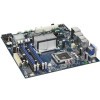- Qualcomm Launches Snapdragon 4 Gen 2 Mobile Platform
- AMD Launches Ryzen PRO 7000 Series Mobile & Desktop Platform
- Intel Launches Sleek Single-Slot Arc Pro A60 Workstation Graphics Card
- NVIDIA Announces Latest Ada Lovelace Additions: GeForce RTX 4060 Ti & RTX 4060
- Maxon Redshift With AMD Radeon GPU Rendering Support Now Available
Intel Desktop Board DG45ID

We’re taking a look at Intel’s first attempt at a full-featured media center motherboard, the DG45ID. It’s also our first look at their new G45 Express chipset, which promises to finally bring DX 10 support and hardware-accelerated HD video playback to their integrated graphics offerings. Can the DG45ID prove itself a worthy choice for your HTPC?
Page 5 – SYSmark 2007 Preview, Intel DHCAT 3.0
Synthetic benchmarks have typically been favored for performance testing, but the results they provide can be fairly abstract, and the methods they use to assign their scores can be dubious at times. By contrast, real-world application benchmarks provide performance metrics that apply directly to real-world usage, and we endeavor to apply both in our performance comparisons.
SYSmark 2007 Preview from BAPCo is a special case, because its synthetic scores are derived from tests in real-world applications. However, we still believe that synthetic benchmarking scores are best used to directly compare the performance of one piece of hardware to another, and not for developing an impression of real-world performance expectations. SYSmark is more useful than most synthetic benchmarking programs in our opinion, because its tests emulate tasks that people actually perform, in actual software programs that they are likely to use.
The benchmark is hands-free, using scripts to execute all of the real-world scenarios identically, such as video editing in Sony Vegas and image manipulation in Adobe Photoshop. At the conclusion of the suite of tests, five scores are delivered: an E-learning score, a Video Creation score, a Productivity score, and a 3D Performance score, as well as an aggregated ‘Overall’ score. These scores can still be fairly abstract, and are most useful for direct comparisons between test systems.
A quick note on methodology: SYSmark 2007 requires a clean install of Windows Vista 32-bit to run optimally. Before any testing is conducted, the hard drive is first wiped clean, and then a fresh Windows installation is conducted, then lastly, the necessary hardware drivers are installed. The ‘Three Iterations’ test suite is run, with the ‘Conditioning Run’ setting enabled. Then the results from the three runs are averaged and rounded up or down to the next whole number.


In the SYSMark 2007 benchmarking suite, the DG45ID pulls out an early lead – though it doesn’t put up much of a fight in the E-Learning or Video Creation categories, it surprises the reference ASUS P5E-VM HDMI in the productivity and 3D categories. This could be partially attributed to the performance of the Intel G45 Express chipset’s ICH10 storage controller – since productivity applications draw heavily on storage resources.
Intel Digital Home Capabilities Assessment Tool Pro 3.0
Developed in cooperation with BAPCo, Intel’s Digital Home Capabilities Assessment Tool (DHCAT for short) Pro 3.0 is another synthetic benchmark that tests performance in real-world applications. In this case, the real-world applications are related to the various aspects of audio and video recording, processing, and playback relevant to a media center or home theater PC. As with SYSMark 2007, we conduct our testing on a clean 32-bit Vista install.

Here, we can see that the Intel DG45ID falls behind the G35-based P5E-VM motherboard, in spite of its HD video decoding acceleration. While Intel suggests a different test to determine the performance benefits of the G45 Express chipset’s HD video acceleration, we still expected it to make some difference here as well… apparently it didn’t.
Next, let’s take a look at the DG45ID motherboard’s performance in some real-world multimedia application testing.
Support our efforts! With ad revenue at an all-time low for written websites, we're relying more than ever on reader support to help us continue putting so much effort into this type of content. You can support us by becoming a Patron, or by using our Amazon shopping affiliate links listed through our articles. Thanks for your support!




